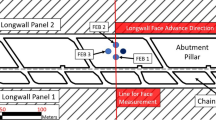Abstract
The paper summarizes the findings of the underground permeability measurements (using inflatable packers) undertaken at a mine site in New South Wales in Australia and highlights the difficulties encountered during packer testing. The research project was supported by the Australian Coal Association Research Project. Within this project, systematic sub-surface and underground hydrogeological monitoring and measurements were carried out e.g. underground packer tests and piezometer, extensometer, and water inflow monitoring during mining. The project was aimed at investigating the effects of longwall mining on strata pore pressure, permeability, and water inflow to facilitate prediction of mining induced aquifer interference and mine water inflow. This paper presents only the results of underground permeability tests conducted at the mine site. The tests show that the drivage of main headings (roadways) can induce a significant change in permeability into the solid coal barrier. Permeability can be seen to increase by as much as 50 times at a distance of 11.2–11.5 m from the roadway rib. The measured permeability values varied widely and strangely on a number of occasions; for example the test conducted from the main headings at 8.2–8.5 m test section in the solid coal barrier showed a decline in permeability value compared to that at 11.2–11.5 m section contrary to the expectations. The tests conducted in the roof strata near (above) the longwall goaf indicated a possibility of more than 1,000 fold increase in permeability. Though the underground packer testing appears to be a good technique for measuring in situ permeability of rocks and coal seams, the study highlighted that (1) boreholes for packer testing need to be drilled with extreme care so as to avoid any undue damage or smearing of the borehole wall and (2) a sufficient number of tests at a number of locations needs to be conducted to cater for the possible variations of the test results.












Similar content being viewed by others
References
Forster I, Enever J (1992) Hydrogeological response of overburden strata to underground mining. Off Energy Rep 1:104
Galvin JM (1987a) Surface subsidence mechanisms—theory and practice, Part I—theory. Coal J 16:31–41
Galvin JM (1987b) Surface subsidence mechanisms—theory and practice, Part 2—practice. Coal J 17:11–25
Guo H, Adhikary DP, Gabeva D (2008) Hydrogeological response to longwall mining. ACARP Report C14033, Australian Coal Association Research Project, p 148
Holla L (1997) Ground movement due to longwall mining in high relief areas in New South Wales, Australia. Int J Rock Mech Min Sci 34(5):775–787
Holla L, Armstrong M (1986) Measurement of subsurface strata movement by multi-wire borehole instrumentation. Bull Proc Aust Inst Min Metall 291(7):65–72
Kenny P (1969) The caving of waste on longwall faces. Int J Rock Mech Min Sci 6:541–555
Kesseru Z (1984) Empirical and theoretical methods for designing soft semi-permeable protective barriers. Int J Mine Water 3(2):1–13
Kratzsch H (1983) Mine Subsidence Eng. Springer, Berlin, p 146
Lai X, Cai M, Ren F, Xie M, Esaki T (2006) Assessment of rock mass characteristics and the excavation disturbed zone in the Lingxin Coal Mine beneath the Xitian river, China. Rock Mech Min Sci 43(4):572–581
Orchard RJ (1974) Statement to inquiry into coal mining under stored waters on behalf of Department of Mines N.S.W., p 24
Ropski ST, Lama RD (1973) Subsidence in the near-vicinity of a longwall face. Int J Rock Mech Min Sci 10:105–118
Seedsman R (1996) A review of the hydrogeological aspects of Australian longwalls. In: McNally and Ward (eds) Symposium on geology in longwall mining, pp 269–272
Sengupta M (1993) Environmental impacts of mining, monitoring, restoration, and control. Lewis Publishers. A CRC Press Company, London
Silitsa IG, Vasilenko GT (1969) Determining safe working depth below quicksand in Western Donbass, Ugol Ukrainy, (In Russian)
Singh RN (1986) Mine inundations. Int J Mine Water 5(2):1–28
Singh MM, Kendorski FS (1981) Strata disturbance prediction for mining beneath surface water and waste impoundments, Proceedings of the First conference on ground control in mining, West Virginia University, pp 76–89
Singh RN, Hibberd S, Fawcett RJ (1986) Studies in the prediction of water inflows to longwall mine workings. Int J Mine Water 5(3):29–46
Waddington AA, Kay DR, Raper WJR, Wold MB, Choi X, Hebblewhite B, Wybrow P (2001) Research into the impacts of mine subsidence on the strata and hydrology of River Valleys and development of management guidelines for undermining cliffs, gorges and river systems. ACARP Research Report No. 74 (Project No. C8005)
Wang JA, Park HD (2003) Coal mining above a confined aquifer. Int J Rock Mech Min Sci 40:537–551
Wardell K (1975) Mining under tidal waters, Report to N.S.W. Ministry for Mines and Power
Whittaker BN, Reddish DJ (1989) Subsidence occurrence, prediction and control. Elsevier
Winters WR, Capo RC (2004) Ground water flow parameterisation of an Appalachian coal mine complex. Ground Water 42(5):700–710
Wold MB, Jeffrey RG (1999) A comparison of coal seam directional permeability as measured in laboratory core tests and in well interference tests. SPE Paper 55598 presented at the 1999 SPE Rocky Mountain Regional Meeting, Gillette Wyoming, May, pp 185–193
Wold MB, Connell LD, Choi SK (2006) Variability of coal seam parameters for improved risk assessment for gas outburst in coal mines. ACARP Project C11030—CSIRO
Acknowledgments
The authors are highly grateful to (a) the Australian Coal Association Research Program for funding this research project, (b) Springvale Colliery for providing the test site and logistics and (c) the CSIRO Petroleum team for conducting the packer tests at the mine site.
Author information
Authors and Affiliations
Corresponding author
Rights and permissions
About this article
Cite this article
Adhikary, D.P., Guo, H. Measurement of Longwall Mining Induced Strata Permeability. Geotech Geol Eng 32, 617–626 (2014). https://doi.org/10.1007/s10706-014-9737-8
Received:
Accepted:
Published:
Issue Date:
DOI: https://doi.org/10.1007/s10706-014-9737-8




